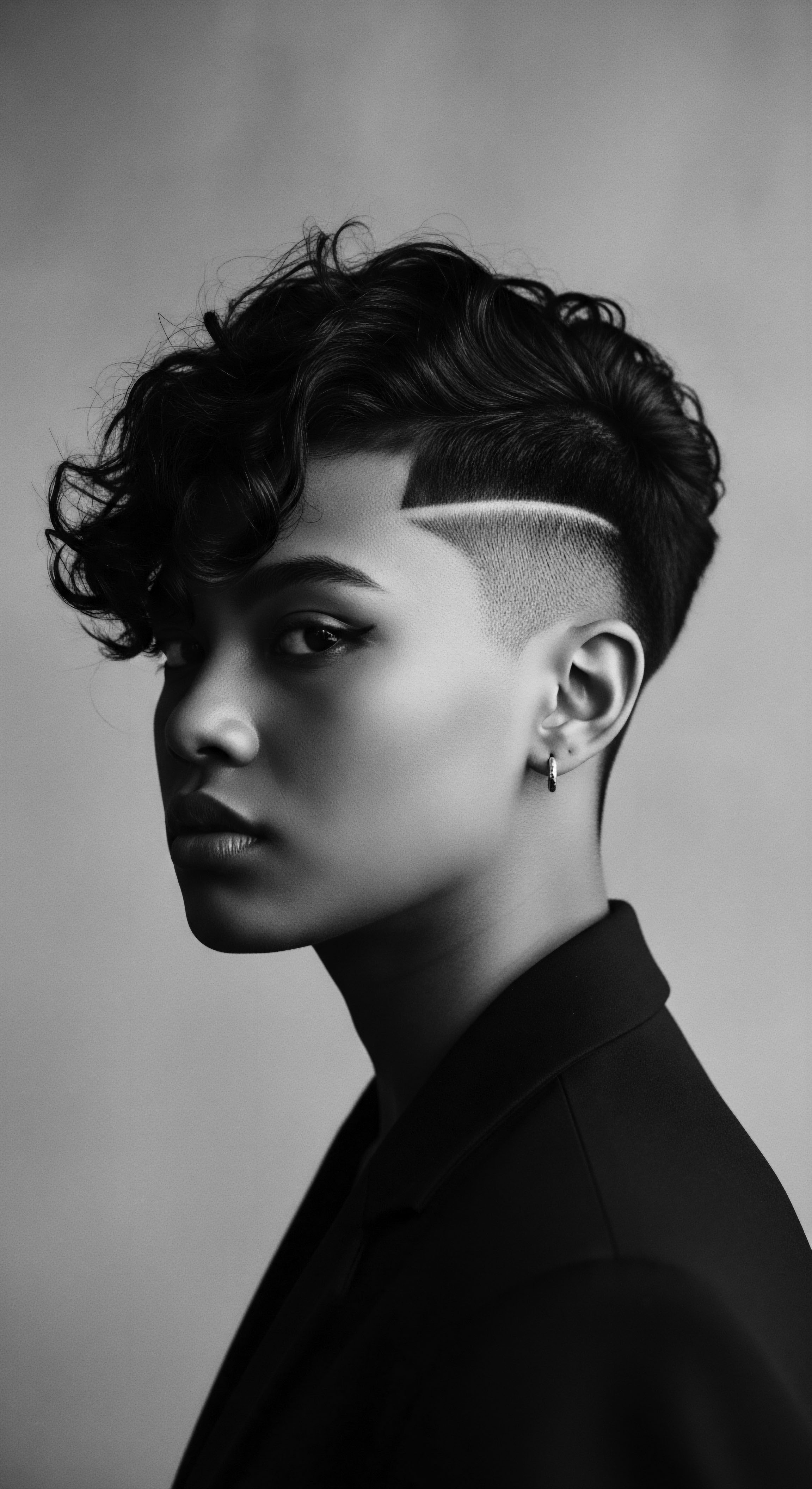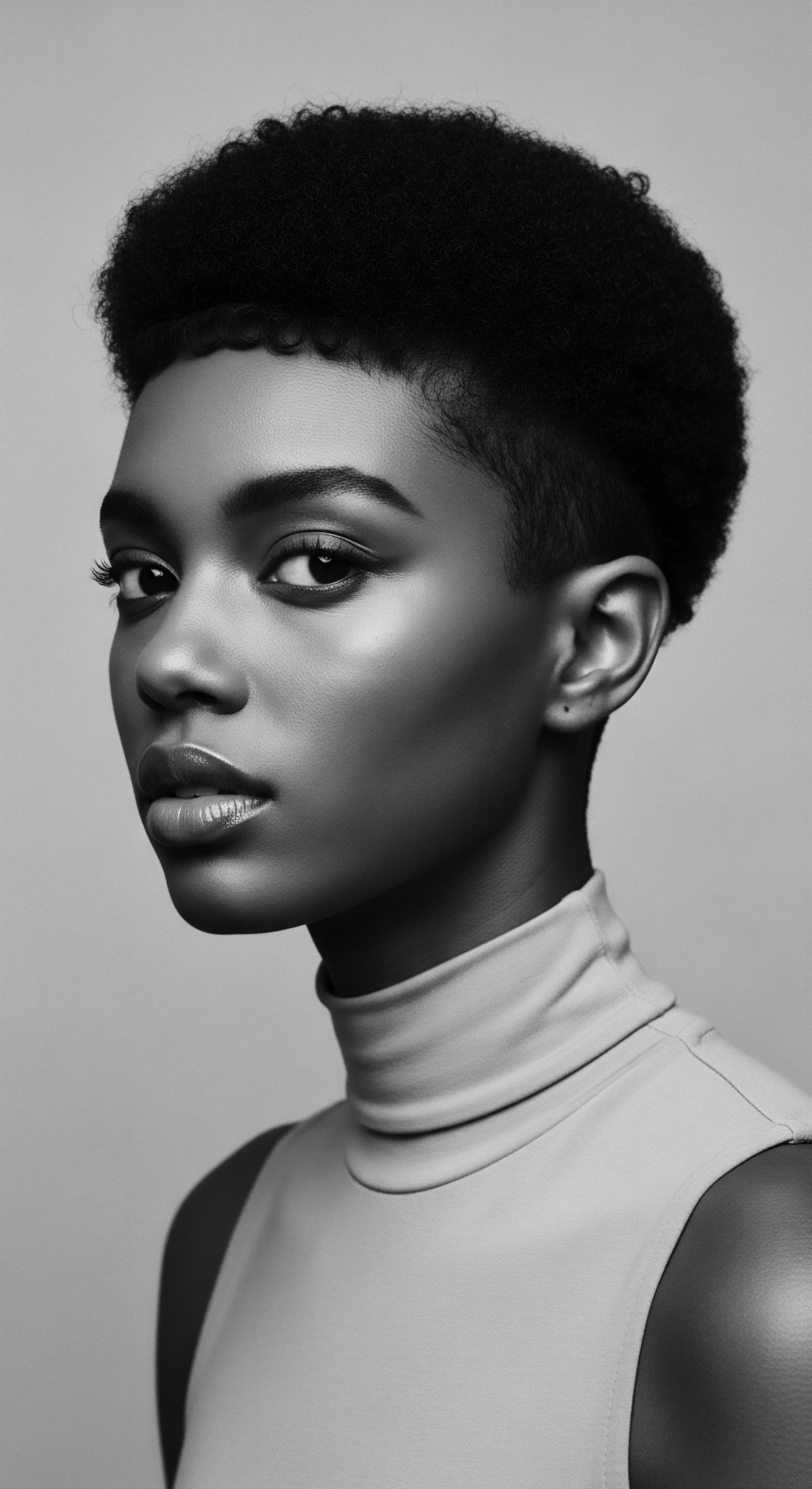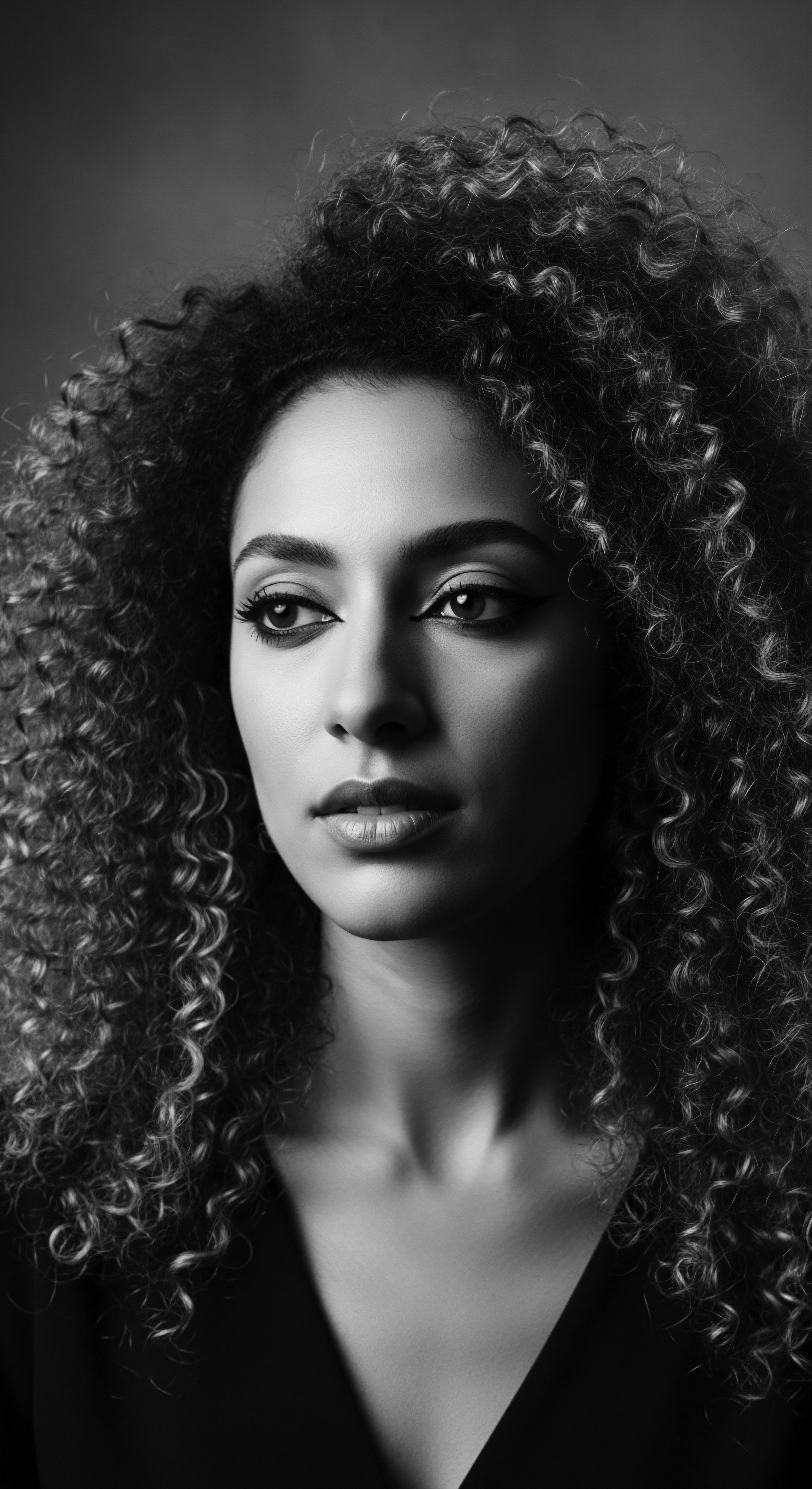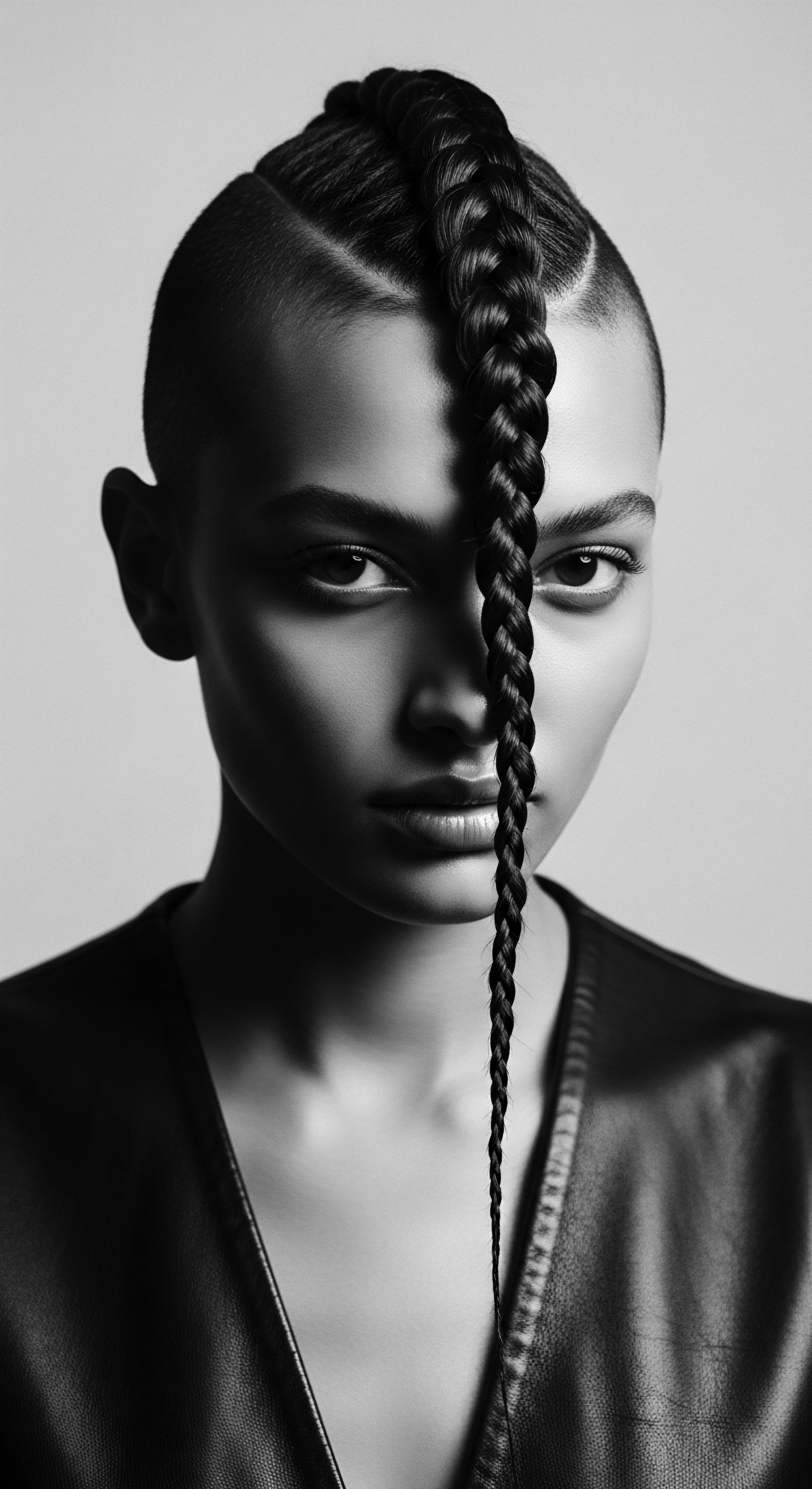
Roots
Consider the deep, resonant rhythm of ancient African life, a rhythm tied intrinsically to the earth, to the sky, and to the very strands upon one’s head. For generations, long before the advent of modern laboratories, African communities understood hair as a living archive, a scroll unfurling the lineage, the wisdom, and the very spirit of a people. The journey of preserving hair length, particularly for those with the glorious, often intricate textures that define Black and mixed-race heritage, was not a matter of fleeting fashion. It was a profound engagement with the natural world, a careful dance with botanicals that held within them the secret to strength, resilience, and growth retention.
These were not isolated endeavors, but rather a collective understanding, passed down through the gentle touch of grandmother to child, echoing in communal gatherings. The botanicals used were not simply applied; they were understood, their properties observed over countless seasons. The very essence of these plants became intertwined with the identity of the communities.

Anatomy and Physiology of Textured Hair
To truly grasp the genius of ancient African hair care, we must first appreciate the unique architecture of textured hair itself. Unlike straight hair, which typically has a round cross-section, coily and kinky strands present an elliptical or flattened shape. This structural distinction shapes the way natural oils, known as sebum, travel down the hair shaft. On straighter hair, sebum glides easily, providing natural lubrication.
For highly coiled strands, this journey is much more arduous, leaving the ends often drier and more susceptible to breakage. This inherent characteristic was not a flaw but a design demanding a particular kind of care, one deeply understood by ancestral hands. The cuticle, the outermost layer of the hair, also behaves differently; it tends to be more raised in textured hair, which can make it more prone to tangling and moisture loss. This insight, gleaned through generations of observation, shaped the choice of botanicals.
Ancient African communities recognized the unique structural needs of textured hair, leading to specialized botanical applications for length preservation.
Moreover, the growth cycle of hair, while universal, experienced nuanced influences in these environments. Factors like climate, nutrition, and lifestyle all played a part, and ancestral practices adapted to these conditions. When we discuss length preservation, it is not about magically accelerating growth, but about fostering an environment where the hair that does grow can remain attached, strong, and vibrant for its natural lifespan. This meant minimizing breakage, a constant challenge for textured hair which, due to its coiling pattern, can be inherently fragile at points of curvature.

The Foundational Botanical Lexicon
The language of ancient hair care was spoken through the plants themselves. Specific terms existed for various preparations and their uses, rooted in local dialects and community knowledge. These were not generic concoctions; each ingredient was chosen with purpose, reflecting generations of empirical wisdom. The materials harvested from the earth were more than mere substances; they were conduits of ancestral knowledge.
- Shea Butter ❉ Derived from the nuts of the shea tree (Vitellaria paradoxa), abundant across the West African savanna. It served as a potent emollient, sealing moisture into the hair shaft, and providing a protective barrier against harsh environmental elements like sun and wind. Its rich fatty acid profile made it ideal for nourishing dry, brittle strands.
- Baobab Oil ❉ Extracted from the seeds of the majestic baobab tree (Adansonia digitata), found throughout many parts of Africa. This oil, often considered a liquid gold, provided essential fatty acids, strengthening the hair and imparting elasticity, thereby reducing breakage.
- Aloe Vera ❉ Known for its soothing and hydrating properties, the gel from the aloe plant (Aloe barbadensis miller) was used to calm irritated scalps, reduce inflammation, and provide a burst of hydration to dry coils. It was often applied directly or incorporated into rinses.
- Moringa ❉ From the ‘miracle tree’ (Moringa oleifera), prevalent in East Africa. Moringa leaves and oil were utilized for their rich vitamin and mineral content, contributing to overall hair health and supporting the integrity of the hair follicle.

How Ancestral Practices Nurtured Length
The preservation of hair length in ancient African communities stemmed from a multifaceted approach, blending botanical application with meticulous care. It was an understanding that length was a byproduct of health, not a standalone pursuit. This integrated wisdom involved several key elements:
- Moisture Fortification ❉ Botanicals rich in emollients and humectants were regularly applied to hair, preventing the dehydration that often leads to breakage. This was particularly significant given the open cuticles of textured hair.
- Strand Strengthening ❉ Ingredients with protein-like compounds or those known to reinforce the hair’s internal structure were sought out, minimizing vulnerability to external stressors.
- Scalp Wellness ❉ A healthy scalp is the foundation of healthy hair. Botanicals with antiseptic, anti-inflammatory, or nourishing properties were applied to maintain a clean, balanced scalp environment, crucial for sustained growth.
| Botanical Source Shea Tree (Vitellaria paradoxa) |
| Traditional Preparation Butter, often warmed and massaged |
| Hair Benefit for Length Preservation Moisture seal, anti-breakage, protective barrier |
| Botanical Source Baobab Tree (Adansonia digitata) |
| Traditional Preparation Oil extracted from seeds |
| Hair Benefit for Length Preservation Elasticity, strength, deep conditioning |
| Botanical Source Aloe Plant (Aloe barbadensis miller) |
| Traditional Preparation Fresh gel directly applied or in rinses |
| Hair Benefit for Length Preservation Scalp soothing, hydration, reduced frizz |
| Botanical Source These ancestral insights laid the groundwork for modern understanding of hair biology and care, particularly for textured hair. |
The careful selection of these botanicals, often specific to regional availability and long-held knowledge, underscores a sophisticated approach to hair care. It was a holistic system, where the health of the individual, the community, and the environment were intrinsically linked to the vibrancy of one’s hair. This foundational wisdom continues to inform contemporary textured hair care practices, acting as a profound echo from the source.

Ritual
The application of botanicals for hair length preservation in ancient African communities transcended mere product use; it was often embedded within ritualistic practices, a tender thread connecting daily life to ancestral wisdom. These were not hurried affairs but deliberate acts of care, often communal, reinforcing social bonds and cultural identity. The process itself contributed to the efficacy, allowing sufficient time for botanicals to truly nourish and protect the hair.

How Did Application Methods Preserve Hair Length?
Ancient communities employed a variety of ingenious methods to apply botanicals, each designed to maximize their benefits and minimize hair manipulation that could lead to breakage. The objective was to ensure deep penetration, even distribution, and long-lasting protection.
Consider the practice of hair oiling, perhaps one of the most widespread and enduring traditions across Africa. Rich, plant-derived oils, such as shea butter or baobab oil, were warmed gently and massaged into the scalp and along the hair strands. This process stimulated blood circulation in the scalp, promoting a healthy environment for growth.
The oils then coated the hair, reducing friction between strands, a critical factor in preventing the mechanical damage that plagues textured hair. The meticulous application, often performed during quiet moments or communal grooming sessions, allowed the botanicals to fully penetrate the hair shaft and fortify its outer layers.
Herbal rinses also held a significant place. Infusions of various leaves, barks, and flowers were prepared and used as a final rinse after cleansing or as a standalone treatment. These rinses often contained mild astringents, antioxidants, and compounds that could strengthen the hair’s protein structure.
For instance, plants like Hibiscus (Hibiscus sabdariffa) were known to leave hair feeling soft and detangled, making it less prone to knots and snags that could lead to breakage. The act of rinsing also helped to balance the scalp’s pH, creating an optimal environment for hair health.
Traditional African hair rituals emphasized gentle, consistent botanical application to minimize breakage and maximize length retention.
Moreover, the creation of protective styles often went hand-in-hand with botanical application. Braids, twists, and locs, deeply meaningful cultural expressions, were a primary means of preserving hair length. These styles kept the hair tucked away, shielding it from environmental stressors and reducing daily manipulation.
Before or during styling, botanicals would be applied to condition the hair, making it more pliable and less prone to snapping during the styling process. This combination of protective styling and botanical conditioning formed a powerful strategy for maintaining length over time.

Cultural Significance of Hair Preservation Practices
Hair in ancient African societies held profound cultural and spiritual significance. It was a canvas for identity, status, marital state, and community affiliation. Preserving hair length was not merely an aesthetic pursuit; it was an act of reverence for self and lineage. The collective memory of these practices, passed through generations, speaks to their deep roots within the broader cultural landscape.
One compelling historical example that illuminates the connection between botanicals, protective styling, and length preservation is found with the Basara women of Chad, and their ancient practice involving Chebe Powder. This unique preparation, derived from the croton plant (Croton zambesicus or Croton gratissimus), is mixed with oils and applied to the hair, often while it is in braids or twists. The powder coats the hair, creating a protective layer that drastically reduces breakage, allowing the women to retain remarkable length.
This tradition, documented in ethnographic studies and oral histories, is not simply about beauty; it is a ritualistic act performed by women, often together, reinforcing community bonds and preserving a tangible link to their ancestors. The Basara women’s commitment to this practice demonstrates a direct ancestral method for achieving and maintaining significant hair length through botanical means (Aniefiok, 2019).
| Ancient Practice Oiling Scalp and Strands |
| Botanical Role Emollient oils (Shea, Baobab) |
| Impact on Length Retention Lubrication, moisture sealing, reduced friction |
| Ancient Practice Herbal Rinses |
| Botanical Role Infusions (Hibiscus, Moringa) |
| Impact on Length Retention Strengthening, pH balance, detangling |
| Ancient Practice Protective Styling with Botanicals |
| Botanical Role Botanical pastes (Chebe, Omuzumba with butterfat) |
| Impact on Length Retention Reduced manipulation, breakage prevention, environmental protection |
| Ancient Practice These time-honored methods underscore a sophisticated understanding of hair biology and plant properties. |
The care rituals extended beyond mere application. They often involved a profound patience and consistency, a recognition that cultivating healthy hair was a long-term commitment. This rhythmic, intentional approach, deeply ingrained in the daily rhythms of ancestral communities, fostered both physical hair health and a profound sense of self-worth and belonging. The thread of wisdom runs from these early rituals to the vibrant hair care traditions celebrated today.

Relay
The wisdom of ancient African communities regarding hair length preservation with botanicals is not a relic confined to history books; it is a living legacy, a relay race of knowledge passed across generations, adapting and informing contemporary practices. This continuity speaks to the depth of ancestral understanding, often validated by modern scientific inquiry, revealing how long-held traditions hold profound truths about hair biology and care. The sophisticated interplay of plant chemistry and hair structure formed the bedrock of these practices, allowing them to stand the test of time.

How Does Science Explain Ancient Botanical Success?
Contemporary scientific analysis often reveals the very compounds within these traditional botanicals that contributed to their efficacy in preserving hair length. What was once observed through trial and error, through generations of lived experience, can now be understood at a molecular level.
Consider the fatty acid profiles of shea butter and baobab oil. These are rich in oleic acid, stearic acid, and linoleic acid. These lipids are incredibly effective at penetrating the hair shaft, reinforcing the hair’s natural lipid barrier, and coating the cuticle.
This action reduces porosity, which is especially beneficial for textured hair that can otherwise lose moisture rapidly. By fortifying this barrier, the hair becomes less susceptible to external damage, such as friction from styling or environmental exposure, which are primary culprits of breakage and, consequently, length loss.
Beyond emollients, many traditional African botanicals possess a wealth of antioxidants, vitamins, and minerals. Moringa, for instance, abounds in vitamins A, C, and E, alongside various amino acids, which are the building blocks of keratin, the protein that makes up hair. These nutrients support the hair follicle, promoting a healthier growth phase and strengthening new growth.
Similarly, the mucilage found in plants like aloe vera provides a slip that aids in detangling, minimizing breakage during manipulation. The anti-inflammatory properties of certain plant extracts also contribute to a healthy scalp microbiome, a crucial foundation for sustained hair growth.
Modern science validates ancestral botanical wisdom, uncovering the molecular mechanisms behind length preservation.
The Basara women’s use of Chebe Powder offers a compelling case study of traditional practice meeting scientific explanation. While not a direct growth stimulant, the powder’s ability to coat the hair strands provides a physical barrier. This coating, combined with the oils it is mixed with, acts as a protective shield, preventing mechanical damage and moisture loss. The efficacy lies in its remarkable ability to reduce friction and tangling, two significant contributors to breakage in tightly coiled hair (Ugbogu, 2019).
The continuous application over time ensures that the hair, as it grows, is consistently protected, allowing it to reach its terminal length without succumbing to external stressors. This method, passed down through generations, effectively ‘holds onto’ the length that the hair naturally produces.

The Enduring Legacy of Botanical Hair Care
The ancestral methods of preserving hair length with botanicals represent a profound legacy, a testament to the ingenuity and deep connection to nature within African communities. This wisdom has not only preserved physical length but has also served to maintain cultural integrity, collective memory, and a sense of shared identity across the African diaspora.
The practices, often rooted in specific regional ecologies, demonstrate a sophisticated understanding of localized flora. For example, the use of desert date oil (Balanites aegyptiaca) in arid regions, or palm oil (Elaeis guineensis) in West and Central Africa, reflects an adaptive and resourceful approach to hair care based on readily available, effective resources. These diverse traditions speak to a rich mosaic of knowledge systems.
The very act of nurturing hair with elements from the earth carries symbolic weight. It speaks to concepts of growth, resilience, and continuity. This communal and personal relationship with hair, grounded in botanical remedies, stood in stark contrast to imposed Eurocentric beauty standards that often devalued textured hair. In preserving their hair, these communities also preserved a part of their authentic self, a vibrant expression of their heritage.
| Botanical Attribute Emollient/Moisturizing |
| Scientific Mechanism Creates a protective film, reduces water evaporation, softens hair |
| Traditional Botanical Examples Shea Butter, Baobab Oil |
| Botanical Attribute Strengthening/Nutrient-Rich |
| Scientific Mechanism Provides amino acids, vitamins, and minerals for keratin synthesis |
| Traditional Botanical Examples Moringa, Fenugreek |
| Botanical Attribute Anti-inflammatory/Soothing |
| Scientific Mechanism Reduces scalp irritation, supports healthy follicle environment |
| Traditional Botanical Examples Aloe Vera, African Basil |
| Botanical Attribute The scientific properties of these plants directly support the ancestral goals of hair health and length retention. |
The continuing dialogue between ancient traditions and modern scientific understanding offers a pathway to truly honor this heritage. By exploring the precise chemical compositions and biological interactions, we gain a deeper appreciation for the intuitive brilliance of those who came before us. This knowledge not only enriches our understanding of the past but also informs sustainable, holistic hair care practices for the future, particularly for those who carry the radiant legacy of textured hair. The relay of this wisdom continues, carried forward by each strand nurtured with ancestral care.

Reflection
The echoes of ancient African communities, their hands gently tending to each coil and curve with the bounty of the earth, whisper through the very Soul of a Strand. This enduring heritage of textured hair care, grounded in the meticulous use of botanicals for length preservation, transcends time. It speaks not only to the ingenuity of our ancestors but also to the profound connection between the human spirit, the natural world, and identity. The journey of understanding how these communities nurtured their hair is a pathway to recognizing the intrinsic wisdom held within traditional practices.
It reminds us that care for our strands is, at its heart, care for our lineage, a continuous affirmation of resilience and beauty. The living archive of textured hair continues to tell its story, each individual journey adding a new chapter to this timeless narrative.

References
- Aniefiok, N. (2019). Ethnobotanical Survey of Plants Used in Hair Care Practices in Africa. Journal of Traditional, Complementary & Alternative Medicines, 14(3), 187-195.
- Ugbogu, A. A. (2019). The Science of African Hair ❉ A Review of the Hair Care Practices of the Basara Women of Chad. International Journal of Applied Science and Technology, 9(2), 1-8.
- Kouassi, P. J. & Koné, M. (2017). Traditional Medicinal Plants of Africa. CRC Press.
- Agyare, C. (2019). Medicinal Plants and Traditional Medicine in Africa. Springer.
- Shittu, K. (2018). The African Hair Care Industry ❉ A Historical and Contemporary Analysis. Palgrave Macmillan.
- Oyelana, O. A. & Bankole, A. B. (2014). African Traditional Hair Care Formulations and Their Modern Scientific Validation. Journal of Cosmetology & Trichology, 4(2), 1-5.
